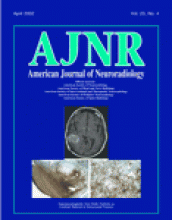Dr Neuwelt and his coworkers have continued their efforts to define the biological activity and possible clinical utility of dextran-coated iron oxide nanoparticles in imaging and therapy. Previous investigators have focused on use of these particles in imaging and quantitating the transport across a disrupted blood-brain barrier and in studying the distribution of convection-delivered fluid in the brain interstitium. The use of iron nanoparticles has also been considered in MR angiography; lymph node imaging; and target-specific imaging, in which they are conjugates to antibodies.
In the article in this issue of the AJNR, Neuwelt et al (see article by Varallyay et al) eliminated the use of Feridex, in its currently allowed doses, as an agent in the clinical imaging of brain tumors because of its inability to breach an disrupted blood-brain barrier. Ferumoxtran-10 (Combidex), likely because of its smaller and more uniform particle size and its more complete dextran coat, passes the incompetent blood-brain barrier and is trapped intracellularly. Therefore, ferumoxtran-10 can serve as a contrast agent for MR imaging; but the evidence reported here does not support its replacement of gadolinium as the contrast agent of choice in brain tumor imaging; ferumoxtran-10 enhancement appears to be far more inconsistent and variable than gadolinium enhancement.
Ferumoxtran-10 has a prolonged enhancement timeline, with sharp delineation of tumor margins at 24 hours after injection. These characteristics might make this contrast agent better than gadolinium-based media when surgery with intraoperative MR imaging is planned; gadolinium-based agents have the unfortunate quality of leaking from the blood or across the blood-brain barrier into the surgical cavity and interfering with the image when it is administered intraoperatively. An increasing number of dedicated MR imaging units are being placed in operating rooms worldwide, and they are intermittently used during the frequently prolonged course of brain tumor resection. The use of long-lived agents such as ferumoxtran-10 might be appropriate in protracted operations if the preoperative administration and the clearance of the agent from the blood before intraoperative imaging can be timed correctly. Because intraoperative MR imaging is proving to be useful in evaluating the extent of the resection of gliomas (particularly) and pituitary tumors, the spotty and unpredictable enhancement with the iron oxide particles with these tumors is disappointing.
As the authors point out, gene therapy has potential in the treatment of brain tumors and other disorders. The ability to predictably deliver the virus into the brain has been one of major clinical obstacles. The authors have concluded from previous studies in rodents that iron oxide nanoparticles seem to have a similar volume of distribution after direct injection into the brain as adenoviruses and a similar ability to get into the intracellular compartment as adenovirus and herpesvirus through a blood-brain barrier. Because, in this study in humans, the iron oxide particles accumulated in tumor and normal brain in both the interstitial space and intracellular compartment, the authors postulate that the iron oxide particles might be a valuable tracer for the transvascular or interstitial delivery of viral vectors.
However, the animal data that are used to compare the movement of iron oxide particles to that of viruses to and through the brain is far from conclusive. The proteins on the surface of viruses make their movement past cell-surface receptors exceedingly complex. As a result, the distribution of viruses through brain tissue is somewhat unpredictable compared with that of inert iron particles. Recently, several groups, studying the potential of delivery of adeno-associated viruses for gene therapy by using convection-enhanced delivery at slow infusion rates, have indirectly shown the interaction of viruses with cells in the brain interstitium. In these studies, the coinfusion of either mannitol or heparin reduced the binding of viruses to cells near the infusion site and allowed the viruses to move further afield to improve the volume of distribution and gene transduction.
The growing interest in gene therapy for brain tumors and the poor viral gene expression in brain tumor trials to date has made the study of convection-enhanced delivery and other methods of optimizing the distribution of viruses in the brain imperative. To be successful in these pursuits, the tracking of viruses and/or imaging of gene transduction is essential. In a promising approach developed at our center, a marker gene for herpes thymidine kinase (HSV1-tk), is included in the viral genome and co-expressed in the target cell. Then, a radiolabeled marker substrate, 2′-fluoro-2′-deoxy-1-beta-d-arabinofuranosyl-5-[(124)I]iodouracil (FIAU), is delivered. This substrate is metabolized by HSV1-tk, trapped within the transduced cell, and detected with positron emission tomography. Because this approach is used to directly image an expressed gene, it should be superior to tracking the movement of iron particles, which can only model the movement of the viruses without assessing their ability to express their genes intracellularly.
- Copyright © American Society of Neuroradiology












